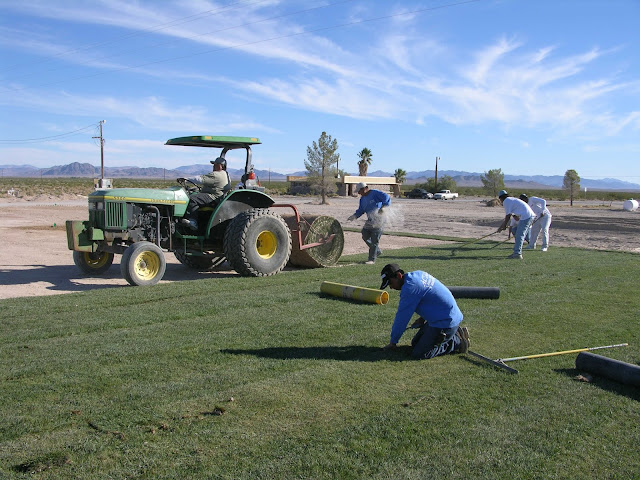Q. About three weeks ago I
laid tall fescue sod in my backyard. I
put some top soil under it for a base before I laid it. I religiously watered the sod twice a day.
Today I removed the sod because it was all dead. No roots emerged. Where did I
do wrong?
laid tall fescue sod in my backyard. I
put some top soil under it for a base before I laid it. I religiously watered the sod twice a day.
Today I removed the sod because it was all dead. No roots emerged. Where did I
do wrong?
A. I am not sure you did
anything wrong. If you kept the sod wet after it was delivered and planted it
right away, it should have grown.
anything wrong. If you kept the sod wet after it was delivered and planted it
right away, it should have grown.
I have seen problems with sod when it was laid on very
hot ground. During the middle of summer, bare soil can be 165 to 170° F, hot
enough to “cook” the roots of grasses laid on top of it. If you spray Roundup
on bare soil, wait 7 to 10 days before laying sod or planting seed because this
chemical can damage it.
hot ground. During the middle of summer, bare soil can be 165 to 170° F, hot
enough to “cook” the roots of grasses laid on top of it. If you spray Roundup
on bare soil, wait 7 to 10 days before laying sod or planting seed because this
chemical can damage it.
 |
| This sod was laid on hot, dry soil during the middle of summer and not watered until after all of it was installed. The hot, dry soil seared the roots of this sod and caused it to die in patches. |
If soil temperatures are hot, lay the sod during very
early morning hours. If it must be done during the heat, lightly spray the soil
with water just ahead of where you are laying it. The spray of water helps cool
the soil as you’re laying it. The downside is the soil can get quite muddy.
early morning hours. If it must be done during the heat, lightly spray the soil
with water just ahead of where you are laying it. The spray of water helps cool
the soil as you’re laying it. The downside is the soil can get quite muddy.
The best time to plant fescue seed is from the middle of
February until about May 1 and then again from mid-September until middle
November. With sod, extend the season a couple of weeks longer in the spring
and later into the fall.
February until about May 1 and then again from mid-September until middle
November. With sod, extend the season a couple of weeks longer in the spring
and later into the fall.
Topsoil put down for sod should be at least 6 inches deep
or more. Another option is to apply 100% compost, 1 inch deep, and rototill it
into the soil as deep as you can. Roll the soil before laying the sod. After laying
sod, roll it again with a water roller or steel drum roller after it has been
irrigated two or three times. Rolling it and keeping the soil wet helps to
“knit” the sod into the soil beneath it.
or more. Another option is to apply 100% compost, 1 inch deep, and rototill it
into the soil as deep as you can. Roll the soil before laying the sod. After laying
sod, roll it again with a water roller or steel drum roller after it has been
irrigated two or three times. Rolling it and keeping the soil wet helps to
“knit” the sod into the soil beneath it.
Pull on the sod after two weeks and see if it is staring
to “knit” into the soil beneath it.
Knitting is growing roots into the soil
from the sod. If it is knitting, then water less often but water it longer.


